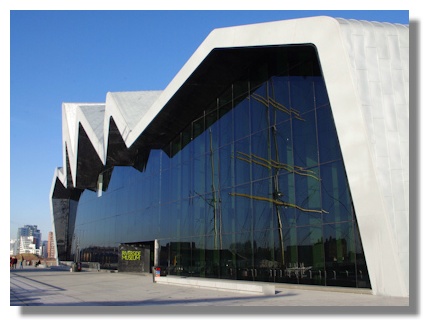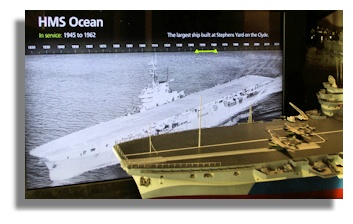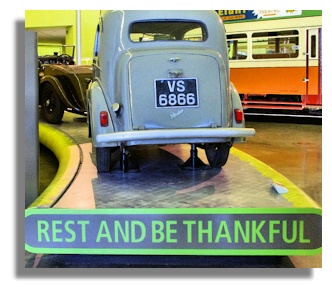
Places to Visit in Scotland
- Riverside Museum Glasgow

Background
Glasgow folk have a soft spot for their museums - and it's not just because they are free and a good place to go when it's raining... Having spent £30 million refurbishing the Kelvingrove Art Gallery and Museum (resulting in increasing the number of visitors to a million in the six months after it reopened), the city council turned their attention to the Transport Museum. This had been in the nearby Kelvin Hall since 1987. Instead of refurbishment, however, it was decided to create a new building on the banks of the river Clyde. The area was already undergoing a massive redevelopment to create "Glasgow Harbour", a major new residential development on land previously used for ship building. The museum building was designed by internationally-renowned architect, Zaha Hadid from Iraq who was appointed in 2004 and the building was opened in June 2011.
The striking new state-of the art Riverside Museum is located at the junction of the Clyde and the river Kelvin. With a floor space of 7,500 sq metres (80,000 square feet) and a roof that represents waves, it houses the huge collection of 3,000 objects including cars, buses, cycles, motor bikes, tram cars, model ships and many other transport-related artefacts. In addition to all those objects there are 92 interactive touch screens, 130 audio-vision screens and 189 video/film clips.
The cost of the Riverside Museum was £74 million, of which the Heritage Lottery Fund provided £21.6 million - the largest Lottery Fund grant to any museum project in Scotland.
Architecture and Layout
Some people may ask "why not a Scottish architect?" But top architects and designers these days are by their nature international and Scottish architects win contracts in other parts of the world such as USA or Russia. The selection was by tender (not by architectural competition) and 140 or so practices expressed an interest in the tender. That number was reduced to a short list invited to tender.
The selection panel chose Zaha Hadid because her proposals ticked all the right boxes: she had the right team, she cost the right amount and the “design approach” was just right, responding appropriately to the brief, understanding the requirement for column-free flexible display space. Her design managed to subtly convey a sense of movement, with a dynamic-looking structure within a building that displays (largely) static objects that used to travel.
The architect Zaha Hadid has established an international reputation for her innovative and contemporary designs. Though her buildings are often described as organic, she is also well known for embracing new technology and materials. She has also been involved in other museum projects including the Rosenthal Centre for Contemporary Arts in Cincinnati, the MAXXI National Museum of 21st Century Arts in Rome, (for which she won the RIBA Stirling Prize for Architecture in 2010) and the Phaeno Science Centre in Wolfsburg, Germany. (The aerial view of the Riverside Museum is copyright Zaha Hadid and Culture & Sport Glasgow Museums).
Right from the start, the design reflected its location by the river Clyde, with an undulating, wave-like roof which is impressive from both external perspectives and from inside. The museum is one of the most complex structures built in the UK, and its self-supporting roof is made up of a latticework of structural steel. The outer “skin” of the museum consists of 24,000 zinc panels on the outer surface, weighing about 185 tonnes. The majority are bespoke and were engineered on site due to the building’s flowing, undulating design.
Inside, there are around 150 separate displays in two main ground floor display areas and a mezzanine floor. The aim is to change at least ten displays each year. Dedicated digital displays allow visitors to find out more about the objects and the stories behind the displays. The digital displays’ text is available in six languages with subtitles.There is a ferry which runs from the museum site across the river Clyde to Govan. Such ferries ran across the river at that spot for hundreds of years and Govan does have an interesting church with a good collection of Pictish stones. But I suspect that most folk will use the ferry just to get a wider panorama of the impressive Riverside Museum skyline with the "Glenlee" sailing ship parked on the river in front of the building.
Motor Cars
Some of the earliest motorcars built by Scottish companies Albion, Argyll and Arrol-Johnson are on display at Riverside, as well as the first Hillman Imp to roll off the production line at Linwood near Paisley. I was particularly struck by an early steam-powered vehicle - until I read how dangerous it was to heat up the water and that it took 30 minutes to get up a head of steam to get it going!Also on display is the caravan that was a fixture at the Faslane Peace Camp for years. You can "meet" Disco Dave and experience what the caravan was like to live in, and find out why Dave was there in the first place.
Some of the cars were displayed on the ground, so it was easy to get up close and take photos. I was greatly relieved to see that the Ford Anglia (the type of car I first drove and owned - for over ten years!) was easily accessible - see picture here.
Others were displayed on a ramp that rose higher and higher, alluding to the "Rest and be Thankful" hill where early cars were tested - if they couldn't make it to the top they wouldn't get into production! But a large number of other cars were mounted on ledges that rose high above the floor of the museum in a "car wall".
Although I understand why they felt they had to do it to display as many cars as possible without taking up a huge amount of floor space, I think the "car wall" is not very successful as visitors are too far away from the vehicles (especially if, like me, they want their own photos). If "my" Ford Anglia had been away up on a ledge on the car wall, I would not have been happy! Admittedly, there are interactive information screens at ground level but that doesn't allow you to get up close to the cars themselves.
Ships
The sailing ship "Glenlee" which used to be moored at a small maritime museum further up the river run by the Clyde Maritime Trust, is now berthed at Riverside, creating a great attraction in this stunning setting. While entry to the museum is free, there is a small charge to see over the "Tall Ship". Glenlee is one of only five Clyde-built sailing vessels afloat in the world today, and the only one in the UK. The Glenlee is a three-masted barque, built in 1896 at Port Glasgow, further down the river Clyde. The Tall Ship spent 12 years at its berth at Yorkhill Quay and attracted about half a million visitors. Features on board now include a new audio-guide facility, an on-board children’s play area, an interactive world map where you can trace the voyages of the Glenlee and rare archive film footage of the Glenlee at sea. (The graphic of the "Glenlee" here is copyright Culture & Sport Glasgow Museums).
The Glenlee was used around the world as a cargo vessel, carrying tea, cocoa, cinnamon and spices from the Far East. For a spell, the ship, with its 21 sails reaching 300 feet high, was part of the Spanish navy as the "Galatea" and was used as a national training ship. Latterly the ship was rotting away but was bought by the Clyde Maritime Trust and brought to Glasgow where it has been lovingly restored. The figurehead on the Glenlee's bow is actually a replica - when the ship was being sold the Spaniards said that they would hand over the original only when Gibraltar was handed back to Spain!
There are 159 ship models in Riverside, more than were on display at the old Museum of Transport. These include models of the Queen Mary, Queen Elizabeth and QE2, the largest ships built on the Clyde. There are also remnants of the paddle steamer Comet, the world’s first commercially successful steamship.
A number of the ship models are accompanied by "story boards" recounting their history and claims to fame. Such as the Athenia which was sunk by a German submarine on 3rd September 1939, the day the Second World War broke out. And the first jet aircraft in the world to land on an aircraft carrier deck was the Royal Navy aircraft carrier "HMS Ocean".
The models are not restricted to Clyde built ships as there are Maori ships from New Zealand and examples of eye-catching war-time camouflage on ships, based on zebra stripes!

While a good number of these are displayed in conventional glass cases, I was most impressed by the "carousel" arrangement whereby many of the models travel one after the other along a conveyer. The transport doubles back creating an ever changing display of lines of ships in motion. All the models pass by an information display which brings up the name and information on each ship - as in this picture of HMS Ocean.
Tram Cars
Glasgow trams are a big part of the city’s history and culture. Riverside has a range of tram cars on display with their story-boards, from the smelly streets of the horse-drawn era to the fashions and frolics of 1960s teenagers travelling on the trams to the dancing - with examples of their dresses worn when going to the "jiggin'".While I am not old enough to recall the horse-drawn tram cars, I can certainly recall travelling on the later models and the bus conductors and conductresses who ruled with stern efficiency. "Come on - get aff!" shouted when the tram was over-full, entered the folk memory of most Glaswegians of that era! Even in my day, the drivers had to stand at the controls all day in the older style trams that were still in operation. When they got to the terminus there was no way for them to circle round - hence the driving positions and passenger entry points at both ends of the vehicle. Even the seat backs could be put in two positions to allow passengers to always face the front.
Trains, Buses, Cycles, Motor Bikes
As with the cars, many of the cycles are displayed high above the museum floor. They are on a display that is designed to look a bit like a velodrome where cyclists compete in high speed races. It is possible to get a bit closer from the observation points on the mezzanine floor. See graphic above!
Graeme Obree leapt to fame on a bike - designed by himself to allow him to break world cycling records; again the actual bike is there in the museum. Danny MacAskill secured his position as an international YouTube star after the release of his terrifying video, Way Back Home. Visitors can see for themselves the bike made famous through his stunts and social media.
Glasgow was once as important for its heavy engineering as it was for its shipbuilding. Riverside’s magnificent steam locomotives are relics of our engineering heyday and a high-tech interactive display will even teach you how to drive one!Glasgow used to be home to the North British Locomotive Company, Europe’s largest manufacturer of steam locomotives. So it's appropriate that the largest object in the Riverside museum is the South African Railways locomotive #3007. #3007 was built at its Queen’s Park Works in Polmadie in 1944–45. At almost four metres (13 feet) in height and 22.5 metres (74 feet) in length and weighing more than 150 tonnes, it’s not just physically impressive, it’s also a magnificent testament to Glasgow’s engineering legacy and the effect its people and exports have had – and continue to have – upon the rest of the world. It was taken out of service in 1988 and lay neglected in South Africa, awaiting the scrap heap for almost 20 years, prior to its move back to Scotland and then to Riverside.
The Glasgow Streets
One of the more popular exhibits at the previous Transport museum in the Kelvin Hall was a mock-up of a Glasgow street from the era 1895–1930, with shop fronts and vintage cars parked in the street. The new Riverside Museum has three street displays spanning the years 1895–1930, 1930–60 and 1960–1980s. Instead of just shop fronts, visitors can go into nine of the shops and see the layouts and goods for sale - with audio-visual displays to help recreate the original atmosphere - that was particularly effective in the replica bar based on a well-known drinking man’s pub of a century ago!
In the two other streets, visitors can enter a garage, a toy shop, clothes shop, pram shop and cinema. While the 1895-1930 "street" was very well done, the other "streets" are harder to find as they are set along one of the walls of the museum with unrelated exhibits obscuring the frontages, with no atmospheric lighting to create an illusion.
In addition to the streets with their shops, throughout Riverside visitors can board two subway cars, three tram cars, four locomotive footplates, one train carriage (of current vintage) and one bus.
Food and Drink
Many visitors will spend an entire day in the Riverside museum and so catering facilities are provided. There is an excellent restaurant on the ground floor overlooking the river and the Tall Ship. On my two visits (so far) to Riverside, I've had haggis neeps and tatties (mashed turnip and creamed potato) and beer battered fish and chips (French fries North America). Both were of a high standard and service was swift. There is also a café on the mezzanine floor offering sandwiches, snacks, tea, coffee and soft drinks. This too has large windows looking down to the river. For those who want to spend as little time as possible on food and drink there are vending machines and a small seating area in a corner of the ground floor.
Location and How to Get There Riverside museum claims to be one of the most accessible museums in the world! You can get there by foot, bike, skateboard, car, bus, train, subway, ferry, helicopter and even seaplane! There is a car park with around 350 spaces and parking is still available beside the old Transport museum which is only a 10 minute walk away.
The Riverside Museum is built on the banks of the River Clyde at Pointhouse Quay in Yorkhill, opposite Govan, where the Clyde meets the River Kelvin. That is about 1km downstream from the Scottish Exhibition and Conference Centre, with the Glasgow Science Centre and the Glasgow Tower across a pedestrian bridge on the south bank of the river. It is a key part of the Glasgow Harbour development.
Opening hours at the museum are Monday to Thursday and Saturday 10am–5pm; Friday and Sunday 11am–5pm.
The museum location is steeped in history, having been the site of a ferry crossing since the Middle Ages, and was at the heart of Glasgow’s industrial past. It is the site of the former A & J Inglis Shipyard, where the paddle steamer Waverley was built and launched. Other shipyards of yesteryear, such as Harland & Wolff and Robert Napier, were close by.
See also the Location on Google Maps (you can change the scale of this map, if required).
Lots More Pictures!
This Web page only has a small sample of the pictures I took during my visits. If you want to see a lot more of the exhibits, there is a Slide Show with an index of thumbnail pictures and also a YouTube style slide show.
Conclusion
Riverside Museum is a great addition to the museums and galleries in Glasgow. It has lots to see and do and is entertaining and informative for all age ranges. While the older generation will enjoy the nostalgia, the younger generation has lots of interactive displays - like being on top of a turntable ladder (not very high but it moves) with a hose to point at a "fire" in an apartment block! Having visited twice already, I am planning to go back again because I know I've missed seeing things as a result of reading a glossy souvenir guide which I bought at the end of the first visit. And I'd like to take that trip on the Govan ferry across the river.The museum is well lit which makes it easier to take photos, regardless of the type of camera you have - the previous Transport Museum had areas where it was hard to see the objects, far less take photos! Having said that, the colour scheme and lighting do create a yellowish cast on some of the photos!
So overall, despite the car wall, Riverside is a great improvement on the Transport Museum in the Kelvin Hall (which I visited many times over the years) And so it should be after spending £74 million!
Return to Index of Places to Visit
Where else would you like to go in Scotland?

